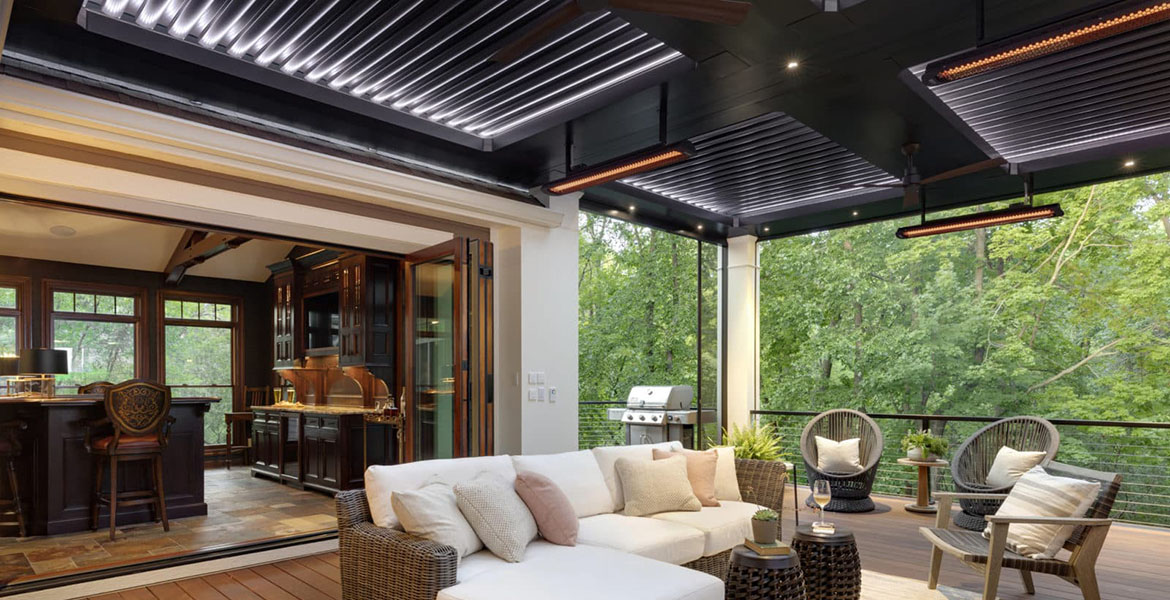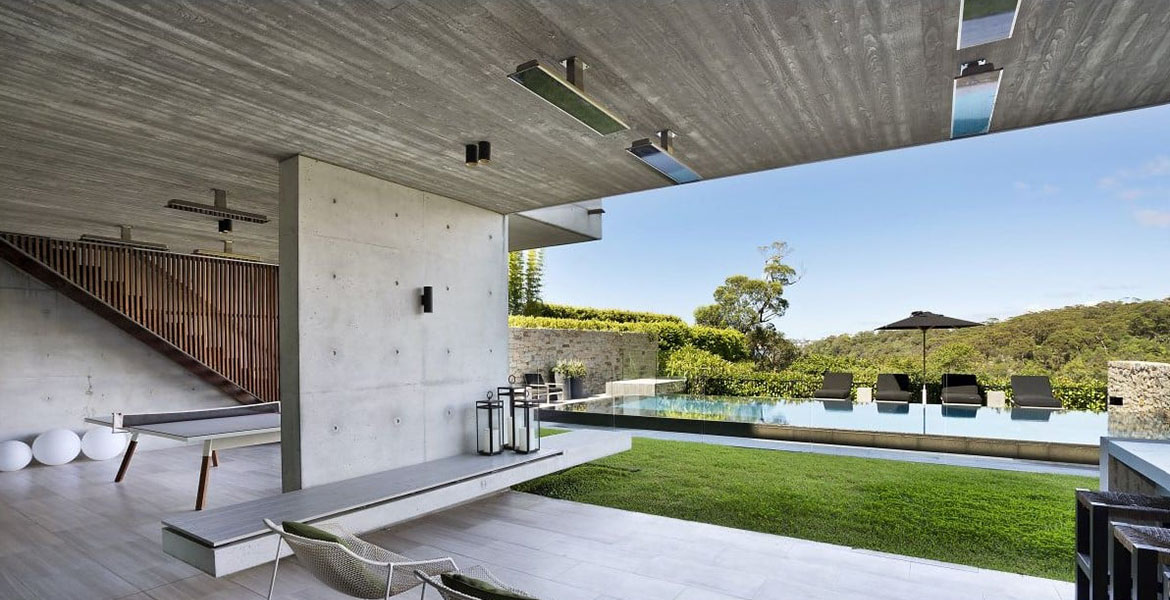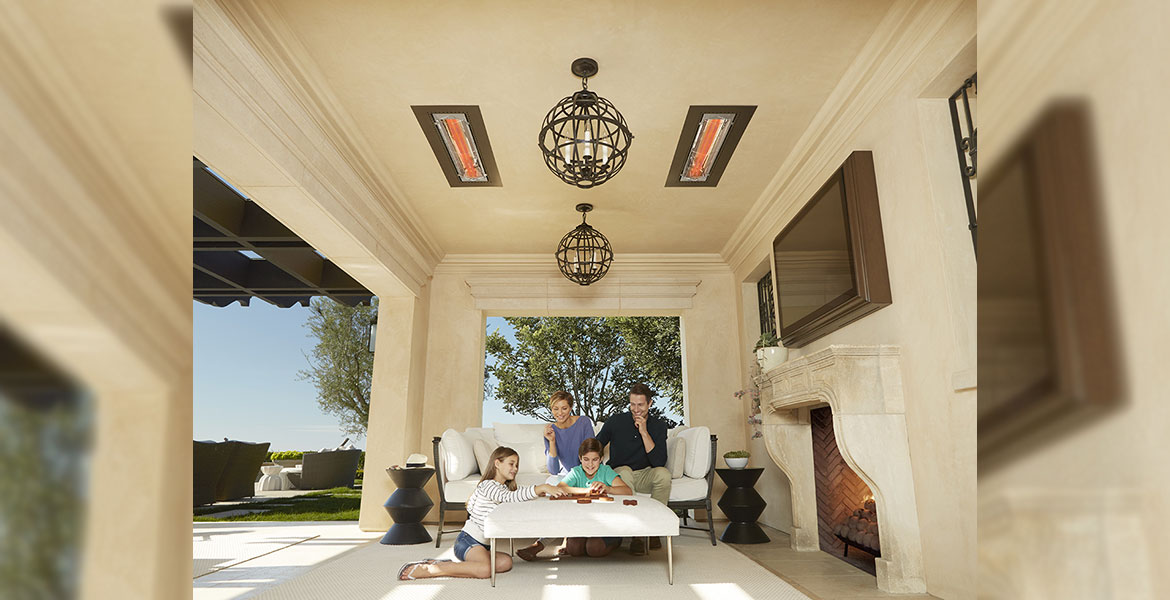How Close to a Ceiling Can a Patio Heater Be? Safety Tips for Patios

It’s no secret that here at Patio Heat and Shade we love spending time outdoors enjoying our backyard oasis, and a key component to keeping our families warm and extending our outdoor time is properly functioning, properly installed patio heaters. Easily the best, most effective upgrade you can make to your outdoor living space, families across the country rely on gas and electric patio heaters to keep the party going long after the sun has jumped off the western horizon.
Once again, we have tapped the amazing brainpower of our patio experts, asking them for tips on how to make your patio heating systems as effective (and safe) as possible. Let’s take a look at their suggestions…

It’s important that your patio heater has enough space around it – including above it
Our patio experts field a bajillion question relating to patio heaters… these come directly from our customers:
- How close can a patio heater be to the ceiling?
- How much clearance do you need above a patio heater?
- How much clearance does a patio heater need?
- How much clearance above a patio heater?
- How much clearance is needed for a patio heater?
- How much overhead clearance for a patio heater?
When thinking about placing your new patio heater in your outdoor space, keep in mind that you’ll need space around the heater for cool air to circulate and prevent the heater from overheating. If your patio heater is fueled by gas (either propane or natural gas) you’ll need extra space and have at least 25% open space to allow venting of carbon monoxide while in operation.
In all cases, clearances will be specified by the manufacturer and should be adhered to rigidly – Check what they say to do, and make sure you do it. Generally speaking:
- Electric Patio Heaters - Whether wall-mounting or ceiling-mounting your electric heater should be no closer than 18” from adjacent walls, 6” from the ceiling and no less than 6’ from the floor. Adjacent heaters should be installed no less than 3’ apart. Note: electric heaters are safe to install in a fully enclosed room and do not require venting options as gas heaters do.
- Gas Patio Heaters – As gas heaters tend to be more powerful than their electric cousins, it’s recommended to have at least 3’ between the gas heater and the ceiling, no less than 6’ from the floor and another three feet to any wall or other combustibles. (Note: Ceiling distance may be significantly lessened with the installation of a heat deflector, to as little as 14”).
Again, it is incredibly important that the installation clearances and instructions for your specific heater be followed for optimal safety and functionality.

Can you use a patio heater under a covered patio?
The answer to this question is a resounding yes-ish. For either gas or electric heaters, the key is to make sure that you have adequate ceiling height (a ceiling of at least 10’ high is recommended), and that the installation guidelines for your specific heater are being followed to the letter. Remember that unlike electric heaters, gas heaters (either natural gas or liquid propane) need more airflow and can NOT be installed in a fully enclosed room.
Make sure you have at least one wall open to the natural beauty that surrounds you, and you’re good-to-go. Another note, make sure you have at least 3’ separating your new heater from any combustibles (like wooden beams and posts).
How close to the ceiling can your patio heater be?
Again, we find our customers to be quite an inquisitive bunch. Recent questions from our patio customers include:
- How close can a patio heater be to the ceiling?
- How much clearance do you need above a patio heater?
- How much clearance does a patio heater need?
- How much clearance above a patio heater?
- How much clearance is needed for a patio heater?
- How much overhead clearance for a patio heater?
Again, we highly recommend that you consult the installation manual for your new patio heater and follow their site recommendations exactly. Generally speaking, an electric patio heater can be mounted 6” from the ceiling while a gas patio heater (since they are generally more powerful and combustible) should be mounted 3’ from the ceiling. Also note that you’ll need at least 6’ from the floor for proper operation. Make sure that you don’t have anything combustible within 3’ of your new heater, including drapes, wooden beams or wooden poles.
Be sure to check your heater’s user manual for the manufacturer’s clearance recommendations
You may have noticed that we’ve mentioned checking the installation instructions for your specific heater multiple times throughout this article. That’s because there are variances based on the manufacturing materials, angles of heat deflection and even coating that will change the recommended installation clearances from one manufacturer to another – indeed, even the same manufacturer may have different installation clearances from one product series to another.
This is a step that is critical to the safety and functionality of your new patio heater… be sure to check the installation manual before you purchase your new heater (most of them are available right here on our site) and follow their instructions exactly.
More tips for using your patio heater safely
- Make sure your heater is on even ground. We love the versatility and portability provided by our freestanding outdoor heaters. The ability to put them in the garage in summer and move them to various locations (like a dining area, a small conversation pit, or even over a chaise lounge for those longer springtime naps) when a little extra heat is warranted makes them an ideal versatile solution. When placing your portable outdoor heater in a new location, be sure to level the ground before placing the footing in place. Even though the best portable heaters have an anti-tilt switch (to shut off the heater automatically as soon as it is no longer in an upright position), keeping the base level is key to getting the safety and functionality out of your freestanding outdoor heater.
- Make sure you have the right kind of fire extinguisher in case of an emergency. If the unthinkable happens, you should have an appropriate fire extinguisher nearby… but make sure it’s the right one:
- Gas Patio Heaters – Use a Class B fire extinguisher
- Electric Patio Heaters – Use a Class C fire extinguisher
- Have your new Patio Heater installed professionally! Mounted (permanent) gas or electric heaters should both be installed by professionals. Both are large systems that need to be firmly mounted (wouldn’t want one coming down on little Liam’s head… well… not most days). Larger electrical systems run on higher voltages, requiring professional electricians to install them safely. Gas (natural or propane) systems require an even higher degree of installation as they require safe gas line installation. Don’t install these systems yourself – leave it to the pros.
- Don’t leave your patio heater on while unattended. Even though nobody plans on mistakes, sometimes they do happen. Pay close attention when children, pets or even intoxicated “adults” are near your patio heaters – safety is and always will be first.

Family and friends love to gather with you outdoors, and as the evenings begin cooling off it’s important that your outdoor patio heater is installed safely and operates at its highest efficiency. Before selecting your outdoor heaters, check out the manufacturer’s installation instructions to make sure that you have the space required to safely run your new system.
Follow these instructions to the letter – your family’s safety depends on it. Finally, have larger electrical and all gas heaters professionally installed to ensure that your infrastructure and system is safely working at its peak efficiency.
Selecting your new heating system is exciting – and making sure you have the right system for your space is the critical step #1 that your family’s safety and warmth depends on. If you’re not sure which system is exactly right for your space, rely on our outdoor patio experts to be there for you. Decades of experience with ensure you get the right system, at the right size, at the right price – all here at Patio Heat and Shade.